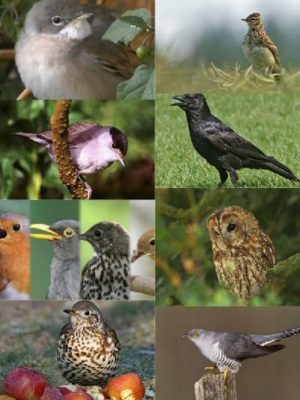
Steve Hallam reports on the 2022 Dawn Chorus walk.
The 2022 Dawn Chorus walk at Hillhouse Wood took place in the midst of a run of warm sunny days, with cool nights. Except for the morning that we chose, which was cloudy and dull but mild. Nevertheless, the publicity team had done an excellent job, resulting in a very pleasing 30 people turning up. I was particularly pleased to find that Jonathan Jukes, the Woodland Trust Regional Manager responsible for the wood, had dragged himself out of bed at such an uncivilised hour, to join us. With the cloud cover, the night was still fully dark, and thus the birds were relatively slow to get going.
What will we see first?
I am always intrigued to find out what the first species of bird heard will be, and hope that it will not be a domestic cockerel – again. This year we avoided this indignity. In fact the first bird heard was at the other end of the ‘glamour’ scale – a Nightingale.
What was unusual this year was that this was swiftly followed by several other birds being noisier than usual; a Tawny owl, and very persistent Cuckoo and perhaps more surprisingly, a Skylark in full song. I wonder how it knows how and where to land in the pitch dark, all this happening some time before the Dawn Chorus proper burst into life. Oh, and a cockerel.
Chorus in Phases
As previous walkers (and readers) may recall, the Dawn Chorus is typically comprised of several phases. First off are the resident songsters – Robin, Blackbird and Wren. And so it was this year; with one exception. Normally, one of the first birds to start is the Song thrush; but this year there was not one. And, throughout, there was one Nightingale singing steadily from the scrub below the top pond.
The night continued to be dark, and the warblers of the second phase continued to slumber, so we had to pause on the edge of the wood. However we eventually heard the first Blackcap start to sing, soon followed by the Chiffchaffs. By the time we were on the path down to the stream the choir was in full song, and achieved full ‘wall of sound’ status.
A marvellous thing to be in the middle of – and the point in the walk when you decide that wrenching yourself from your bed was a good idea after all.
Then it quietens down
As I have mentioned in previous years, it is remarkable how quickly the full-on performance is over. By the time we had reached the bottom of the slope the singing intensity was winding back down to ‘desultory’, with most of the remaining noise being made by a combination of Wrens and Blackcaps. It is only now that the Blue tits and Great tits stir and make themselves known, as do the Carrion crows and Jackdaws.
We walked on through the wood, towards the scrub at the ‘dairy farm’ end where there is normally a Nightingale. There was – but we only heard a snippet of song. I was hoping that we would see or hear, at least, some different birds as we walked back along the track, with its hedgerows.
And, at last, Song Thrushes
What was a surprise was that, having heard none at the start of the walk, we were serenaded by a brace of Song thrushes. Why they did not sing much earlier in the morning is a mystery. Another excellent spot, albeit for the nerdy birdwatchers among us, was to hear a Lesser whitethroat ‘singing’ from inside a thick hedge.
Not so long ago the trackside hedges held good numbers of Whitethroats singing vigorously, if less than beautifully. But times have changed, and numbers have dropped. I had just about given up hope of finding one at all when, to my relief and surprise, one burst into song in the hedge right by the parking triangle. Phew!
The List in order
Click the links to connect to information on the RSPB site including examples of their song.

